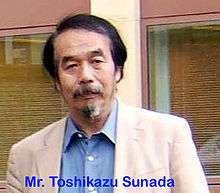Toshikazu Sunada
| Toshikazu Sunada | |
|---|---|
 | |
| Born |
1948 (age 67–68) Tokyo, Japan |
| Nationality | Japanese |
| Fields | Mathematics (Spectral geometry and Discrete geometric analysis) |
| Institutions |
Nagoya University Tokyo University Tohoku University Meiji University |
| Alma mater | Tokyo Institute of Technology |
| Notable awards | Iyanaga Award (1987) and Publication Prize (2013) of Mathematical Society of Japan |
Toshikazu Sunada (砂田 利一 Sunada Toshikazu, born September 7, 1948) is a Japanese mathematician and author of many books and essays on mathematics and mathematical sciences. He is professor of mathematics at Meiji University, Tokyo, and is also professor emeritus of Tohoku University, Tohoku, Japan. Before he joined Meiji University in 2003, he was professor of mathematics at Nagoya University (1988–1991), at the University of Tokyo (1991–1993), and at Tohoku University (1993–2003). Sunada was involved in the creation of the School of Interdisciplinary Mathematical Sciences in Meiji University and is its first dean (2013-).
Main work
Sunada's work covers complex analytic geometry, spectral geometry, dynamical systems, probability, graph theory, and discrete geometric analysis. Among his numerous contributions, the most famous one is a general construction of isospectral manifolds (1985), which is based on his geometric model of number theory, and is considered to be a breakthrough in the problem proposed by Mark Kac in "Can one hear the shape of a drum?" (see Hearing the shape of a drum). Sunada's idea was taken up by C. Gordon, D. Webb, and S. Wolpert when they constructed a counterexample for Kac's problem. For this work, Sunada was awarded the Iyanaga Prize of the Mathematical Society of Japan (MSJ) in 1987. He was also awarded Publication Prize of MSJ in 2013. In a joint work with Atsushi Katsuda, Sunada also established a geometric analogue of Dirichlet's theorem on arithmetic progressions in the context of dynamical systems (1988). One can see, in this work as well as the one above, how the concepts and ideas in totally different fields (geometry, dynamical systems, and number theory) are put together to formulate problems and to produce new results.
His study of discrete geometric analysis includes a graph-theoretic interpretation of Ihara zeta functions, a discrete analogue of periodic magnetic Schrödinger operators as well as the large time asymptotic behaviors of random walk on crystal lattices. The study of random walk led him to the discovery of a "mathematical twin" of the diamond crystal out of an infinite universe of hypothetical crystals (2005). He named it the K4 crystal due to its mathematical relevance (see the linked article). What was noticed by him is that the K4 crystal has the "strong isotropy property", meaning that for any two vertices x and y of the crystal net, and for any ordering of the edges adjacent to x and any ordering of the edges adjacent to y, there is a net-preserving congruence taking x to y and each x-edge to the similarly ordered y-edge. This property is shared only by the diamond crystal (the strong isotropy should not be confused with the edge-transitivity or the notion of symmetric graph; for instance, the primitive cubic lattice is a symmetric graph, but not strongly isotropic). The K4 crystal and the diamond crystal as networks in space are examples of “standard realizations”, the notion introduced by Sunada and M. Kotani as a graph-theoretic version of Albanese maps (Abel-Jacobi maps) in algebraic geometry.
For his work, see also Isospectral, Reinhardt domain, Ihara zeta function, Ramanujan graph, quantum ergodicity, quantum walk.
Selected Publications by Sunada
- T.Sunada, Holomorphic equivalence problem for bounded Reinhardt domains, Math. Ann. 235 (1978), 111-128
- T.Sunada, Rigidity of certain harmonic mappings, Invent. Math. 51(1979), 297-307
- J.Noguchi and T.Sunada, Finiteness of the family of rational and meromorphic mappings into algebraic varieties, Amer. J. Math. 104(1982), 887-900
- T.Sunada, Riemannian coverings and isospectral manifolds, Ann. of Math. 121(1985), 169-186
- T.Sunada, L-functions and some applications, Lect. Notes in Math. 1201(1986), Springer-Verlag, 266-284
- A.Katsuda and T.Sunada, Homology and closed geodesics in a compact Riemann surface, Amer. J. Math. 110(1988), 145-156
- T.Sunada, Unitary representations of fundamental groups and the spectrum of twisted Laplacians, Topology 28(1989), 125-132
- A.Katsuda and T.Sunada, Closed orbits in homology classes, Publ. Math. IHES. 71(1990), 5-32
- M.Nishio and T.Sunada, Trace formulae in spectral geometry, Proc. ICM-90 Kyoto, Springer-Verlag, Tokyo, (1991), 577-585
- T.Sunada, Quantum ergodicity, Trend in Mathematics, Birkhauser Verlag, Basel, 1997, 175 - 196
- M.Kotani and T.Sunada, Albanese maps and an off diagonal long time asymptotic for the heat kernel, Comm. Math. Phys. 209(2000), 633-670
- M.Kotani and T.Sunada, Spectral geometry of crystal lattices, Contemporary Math. 338(2003), 271-305
- T.Sunada, Crystals that nature might miss creating, Notices of the AMS, 55(2008), 208-215
- T.Sunada, Discrete geometric analysis, Proceedings of Symposia in Pure Mathematics (ed. by P. Exner, J. P. Keating, P. Kuchment, T. Sunada, A. Teplyaev), 77(2008), 51-86
- K.Shiga and T.Sunada, A Mathematical Gift, III, American Mathematical Society
- T.Sunada, Lecture on topological crystallography, Japan. J. Math. 7(2012), 1-39
- T. Sunada, Topological Crystallography, With a View Towards Discrete Geometric Analysis, Springer, 2013, ISBN 978-4-431-54176-9 (Print) 978-4-431-54177-6 (Online)
References
- Atsushi Katsuda and Polly Wee Sy,, An overview of Sunada’s work
- Meiji U. Homepage (Mathematics Department)
- David Bradley, , Diamond's chiral chemical cousin
- M. Itoh et al., New metallic carbon crystal, Phys. Rev. Lett. 102, 055703 (2009)
- Diamond twin, Meiji U. Homepage
